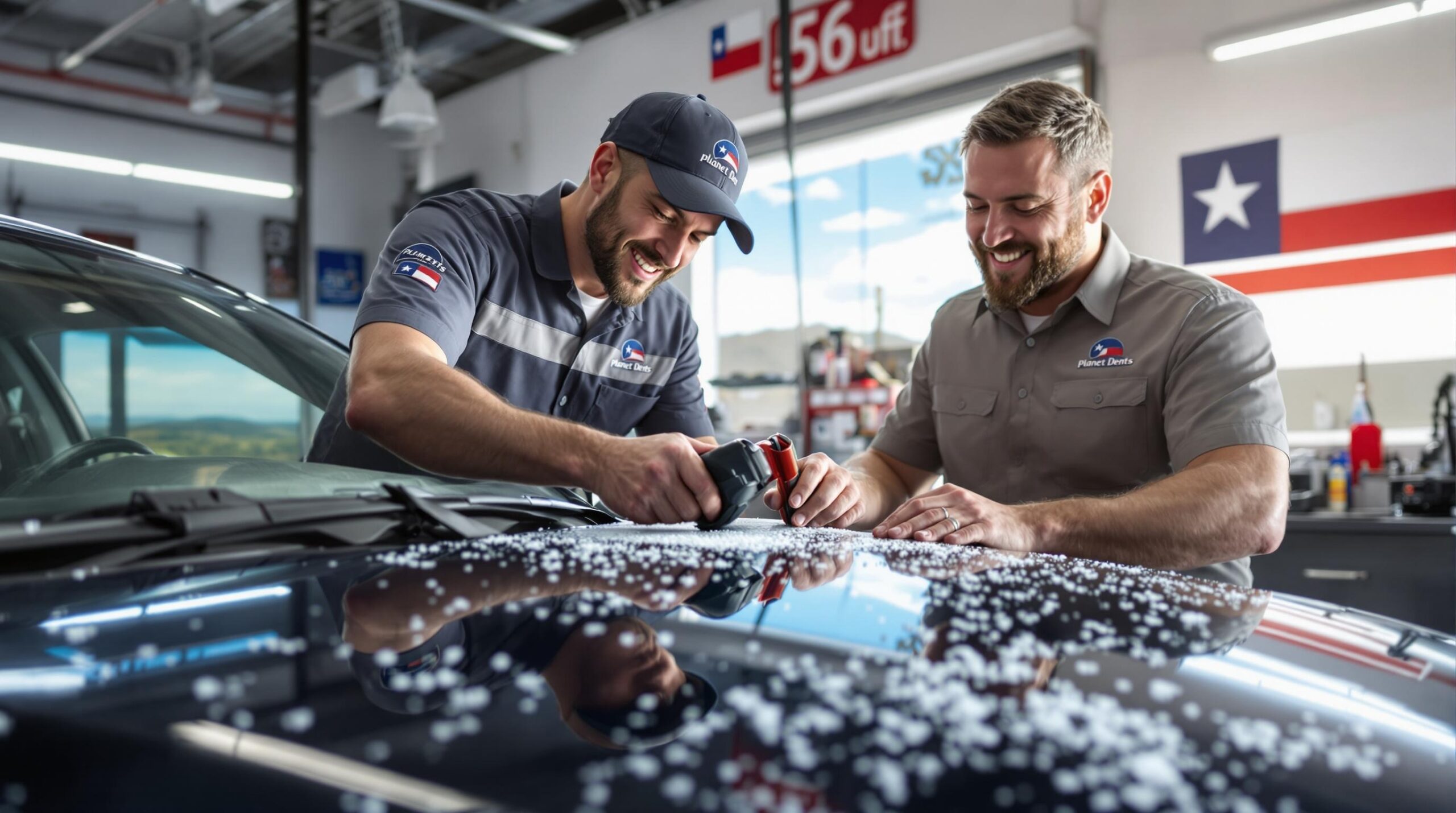Protect Your Car Before the Next Texas Hailstorm: Essential Pre-Storm Tips for Austin, San Antonio, and Central Texas Drivers
Estimated reading time: 5 minutes
- Central Texas faces high hailstorm activity, dubbed “Hail Alley.”
- The average hail damage claim exceeds $4,800 per vehicle.
- Having a proactive protection plan can save you thousands.
- Proper planning can reduce the psychological stress of storm damage.
- Planet Dents offers tailored protection strategies specifically for Central Texas.
Table of Contents
- Why Central Texas Pre-Storm Car Protection Is More Critical Than Ever
- How Planet Dents Solves Vehicle Protection Challenges for Central Texas Drivers
- Your Step-by-Step Experience with Planet Dents Protection Planning
- FAQ
Why Central Texas Pre-Storm Car Protection Is More Critical Than Ever
The question isn’t if the next major hailstorm will hit Central Texas—it’s when. Our region’s geographic position creates a perfect storm recipe that meteorologists call the “Texas Triangle,” where atmospheric conditions regularly produce severe weather from March through October.
The statistics paint a sobering picture. According to the National Weather Service, Central Texas communities like Austin, San Antonio, Round Rock, Georgetown, and Pflugerville experience an average of 12-15 severe weather events annually, with at least 4-6 producing significant hail. The economic impact is staggering: in 2023 alone, Travis County vehicle owners filed over 47,000 hail damage insurance claims, while Bexar County saw nearly 38,000 claims.
What makes Central Texas pre-storm car protection so challenging is the speed at which these storms develop. Unlike hurricanes that provide days of warning, severe thunderstorms can form and intensify within hours. A beautiful sunny morning can transform into a hail-producing supercell by afternoon, catching thousands of drivers with their vehicles completely exposed.
The financial consequences extend far beyond immediate repair costs. Unprotected hail damage typically affects your vehicle’s resale value by 15-20% permanently, even after professional repairs. Insurance deductibles for comprehensive coverage average $500-1,000 in Texas, and filing multiple claims can impact your premium rates for years. Perhaps most frustrating is the time factor—quality hail repair often requires 2-3 weeks during peak storm season when reputable shops like Planet Dents are booked solid with emergency repairs.
Many Central Texas drivers make costly assumptions about storm protection. “My car insurance covers everything, so I don’t need to worry” is dangerous thinking. While comprehensive coverage handles repairs, it doesn’t prevent the deductible expense, rental car logistics, or the depreciation impact on your vehicle’s value. Another common misconception? “Small hail won’t cause real damage.” We regularly see vehicles with hundreds of tiny dents from “pea-sized” hail that still requires extensive PDR work costing $3,000-5,000.
The psychological impact cannot be ignored either. Post-storm anxiety affects thousands of Central Texas families each year. The stress of dealing with insurance adjusters, finding reputable repair shops, coordinating rental cars, and living with damaged vehicles creates emotional strain that proper Central Texas pre-storm car protection can eliminate entirely.
Weather patterns are intensifying, too. Climate data shows that Texas supercells are producing larger hail more frequently than historical averages. The 2023 storm season brought multiple softball-sized hail events to Central Texas—something previously considered rare. This trend makes proactive protection strategies more valuable than ever for preserving your vehicle investment.
How Planet Dents Solves Vehicle Protection Challenges for Central Texas Drivers
At Planet Dents, our 25+ years serving Central Texas families has taught us that the best hail damage repair is prevention. While we’re proud to be the region’s most trusted PDR specialists, we’d rather see your car avoid damage entirely than perform even the most flawless restoration.
Our comprehensive Central Texas pre-storm car protection approach combines weather monitoring expertise, practical preparation strategies, and emergency response planning tailored specifically to our local climate patterns. Unlike generic advice you’ll find online, our recommendations account for Texas’s unique challenges: rapid storm development, extreme temperature variations, and the specific hail patterns we see across Austin, San Antonio, Round Rock, Georgetown, Pflugerville, and Killeen.
Real Success Story: Just last week, Sarah Martinez from Round Rock contacted us with relief in her voice rather than panic. She’d followed our pre-storm preparation checklist when severe weather alerts started pinging Tuesday afternoon. While her neighbors scrambled to move vehicles as marble-sized hail began falling, Sarah’s car was already safely tucked in the covered parking structure at her office building—a location she’d identified months earlier using our preparation strategy.
“I watched the storm from my office window and actually felt calm instead of sick to my stomach,” Sarah explained. “My coworkers were frantically calling insurance companies and looking up body shops on their phones. I was just grateful I’d taken Planet Dents’ advice seriously.” The contrast was stark: Sarah drove home Wednesday morning in her pristine vehicle while three colleagues dealt with significant hail damage, insurance deductibles averaging $750, and the stress of finding reputable repair shops during peak storm season.
This outcome wasn’t luck—it was the result of following our systematic protection approach. Sarah had identified multiple covered parking options near her home and workplace, downloaded reliable weather alert apps we recommend, and created a quick-action plan for different storm scenarios. When the alerts started, she simply activated her pre-planned response.
Our protection methodology starts with microclimate mapping—understanding that hail patterns vary dramatically even within single cities. A storm might devastate North Austin while leaving South Austin untouched, or hammer Georgetown while sparing nearby Round Rock. We help our clients understand their specific risk factors based on geographic location, typical storm paths, and seasonal patterns we’ve observed across thousands of repair jobs.
Advanced warning systems form the second pillar of our approach. We recommend specific weather apps and alert services that provide the granular, location-specific information Central Texas drivers need. Generic weather apps often miss the hyperlocal details that matter—like which side of town is most likely to experience severe hail based on storm movement patterns.
The third component involves strategic shelter identification and accessibility planning. We guide clients through mapping covered parking options at home, work, shopping centers, and frequently visited locations. This isn’t just about finding any overhead protection—it’s about understanding which structures provide adequate protection from wind-driven hail and which might create additional risks.
Our approach also includes rapid response protocols for different storm scenarios. What should you do if a storm develops while you’re shopping? How quickly can you realistically move your vehicle when warnings are issued? What about overnight storms when you’re sleeping? We create personalized action plans that account for your lifestyle, work schedule, and local geography.
Want to see how this systematic approach works for your specific situation? Get a free protection consultation where we’ll assess your home and work locations, identify optimal shelter options, and create your personalized pre-storm action plan.
Your Step-by-Step Experience with Planet Dents Protection Planning
Getting comprehensive storm protection for your Central Texas vehicle is simpler than most people realize. Our step-by-step process ensures you’re fully prepared before the next severe weather event strikes, eliminating the panic and costly mistakes that catch unprepared drivers every storm season.
Step 1: Risk Assessment and Location Analysis (Week 1)
Your protection journey begins with our comprehensive risk assessment. We analyze your home address, workplace location, and frequently visited areas to understand your specific vulnerability patterns. Using 25+ years of local storm data, we identify which areas of your daily routine face the highest hail risk during different seasons. This isn’t generic advice—we’re mapping your actual exposure based on Central Texas microclimate patterns.
During this phase, we also evaluate your current vehicle protection resources. Do you have garage space at home? How about covered parking at work? We assess what’s already available and identify gaps that need addressing. Many clients discover they have protection options they’d never considered, while others learn their current plans have critical flaws that could leave them exposed.
FAQ
What is the best way to protect my car from hail?
Cover your vehicle, ideally with a sturdy structure like a garage or carport. If that’s not available, consider investing in hail-resistant car covers.
How can I stay informed about severe hailstorm warnings?
Use specific weather alert apps that provide detailed, location-based warnings, ensuring you’re informed as storms develop.
Can small hail cause damage to my vehicle?
Yes, even small hail can result in multiple dents, leading to costly repairs. It’s essential to take all hail warnings seriously.
What should I do if hail starts falling while I’m out?
If you’re caught outside, try to find any overhead cover as quickly as possible. If that’s not an option, look for a nearby building where you can shelter your vehicle temporarily.
How long does it usually take to repair hail damage?
Repair times can vary widely, but during peak storm season, expect delays of 2-3 weeks due to high demand for services.


